Helen Atthowe is a farmer, researcher, celebrated pioneer in eco-organic methods and owner of Woodleaf Farm. She and her late husband spoke at many environmental and small farming conferences. In 2012, Woodleaf Farm was recognized with a Steward of Sustainable Agriculture Award at the 32nd Annual EcoFarm Conference. This text is based on a conversation with Nassim Nobari. Find out more about Helen’s work and perspectives at veganicpermaculture.com.
What is your background and what led you to where you are today?
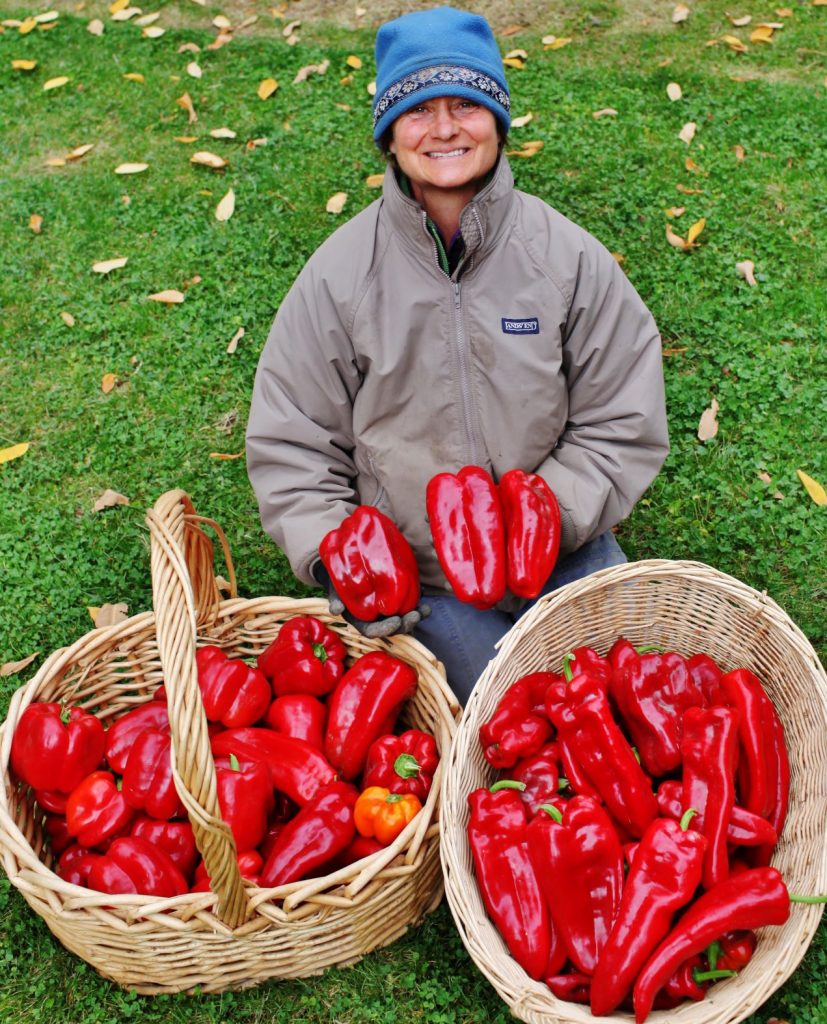
I grew up in western Montana with agriculture and mainly with cattle and grain production, and my grandparents were good horticulturists and raised vegetables and tree fruits. I thought that the food system was the way to change the world. After my first couple of years of undergraduate studies, I realized that “environmental law” meant that I was going to be inside all the time, so I decided, “you know, I’m going to save the world through horticulture!”
I took off for a while and ended up having a wonderful experience, as we often do when we travel in our twenties. I got to study Masanobu Fukuoka’s approach to natural farming. I then went back to finish up college and graduate school in horticulture, plant physiology and agriculture, and I did my research with tree fruits. I went on from there to organic agriculture, in the ’90s when organic agriculture wasn’t cool yet.
I started my own farm in 1993 and was an agriculture extension agent in western Montana. I did that for 17 years, learned a lot, made a lot of mistakes, and started using manure because manure was so prevalent. I was surrounded on all sides by cattle ranchers, and it was free and easy. I was trying to be organic, and I managed to way over-fertilize my soil because I did both manures and living mulches for the first seven years — because I was using Fukuoka’s living mulch approach.
Fortunately, I took soil tests and watched what was going on, kept a lot of records and used my science background, and said, “Whoa, this is not working. What am I doing here?” I was a vegetarian at that point and I said, “I bet I can figure this out without manure. Well, I actually started using less manure because it was resulting in high levels of soil nitrogen and potassium, and partially causing blossom rot in one of my main crops, tomatoes. So, I looked at a different way.
Later, when I went from being vegetarian to vegan and realized what veganic farming was, I said, “I bet I can do this without manures.” I have this lovely piece of data that I present: it’s a chart that says, “A Tale of Two Fields.” It’s shows my first 5 years of using high levels of manures, then next 5 years of using much less manure, and then stopping manure use altogether….
With the new fields, I learned how to farm without being such a nitrogen-focused farmer. I started on the veganic farming, and my partner at the time was a vegan. Then our relationship broke up and I met Carl who was not a vegan. But it turns out we had the same religion, we farmed using living mulches and Carl was a better veganic farmer than I was. He’d been doing it for 20 years. So we worked together on developing an ecological organic farming method using only plant-based fertilizers and ironically, he showed me how to move away from using high nitrogen fertilizer. Going over all of Carl’s long-term soil test data and looking at the quality of the crops, we moved into being committed “carbon farmers”, using a diversity of higher and lower carbon plant fertilizers, some we grew on the farm as living mulches. We did on-farm research into habitat–building for biological control organisms and eventually built up such an abundance and diversity of predators and parasites that we stopped using any organic insecticides on tree fruit crops, which is very unusual.
That led us, finally, to this new farm with 211 acres. Only 70 acres of it are irrigated and the rest is in a wildlife sanctuary. We started pushing the envelope entirely and seeing how we can do minimal soil disturbance plant-based farming with low nitrogen, high carbon-based, and growing all of our fertilizer right on the farm.
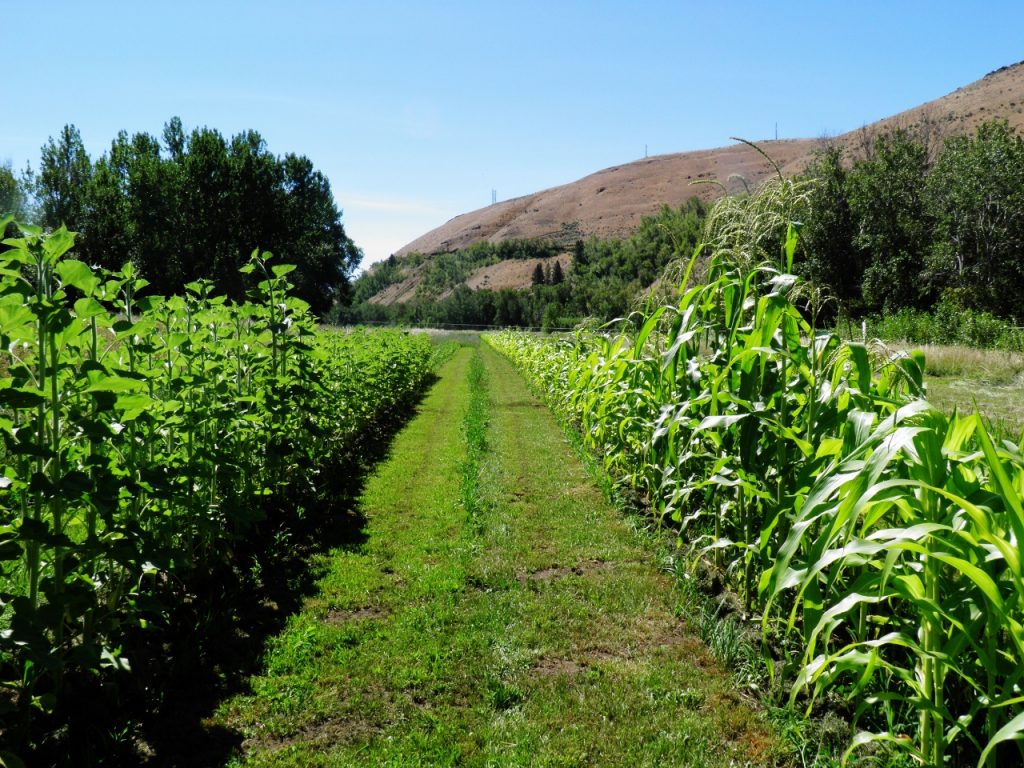
You had already been a farmer for a long time before you became a veganic farmer. Can you speak about that transition?
I had become a vegetarian early on when I realized what happened to the calves that we pulled to save their lives when their mothers were having difficult births. I was really sensitive to animal welfare from an early age. I was never going to raise animals; I became a vegetable and fruit grower, and the only animals at my place were pets. But what made me learn about veganic farming and think that maybe I could have something to do with that, was when I had a vegan partner who sat me down and made me watch, with many tears, all of Earthlings.
When I watched “Earthlings” I said, I can do this. I can figure out how to really do a commercial approach to vegetable and fruit farming without using any animal products. This included manures, but especially things that actually killed animals like fish meal and feather meal — many of the products that organic farmers use regularly. I kind of owe to Earthlings my push into focusing on how to make this work on a commercial level.
You’ve mentioned that you went from being a “conventional organic” farmer, to an agroecological farmer, to a vegan agroecological farmer, and that you consider these to be the three stages of “organic.” Can you elaborate?
I left behind the world of conventional farming about 25 years ago, although as an extension agent, I helped conventional farmers with soil management and insects, diseases and weeds, which is my specialty. But for myself, I was always an organic farmer. When I say “conventional organic,” I mean that what we do in conventional organic farming is that we try to create a healthy product for humans and create a healthy soil. But we tend to use a lot of tillage, both to prepare the soil and to cultivate the soil for weeds, and we also use a lot of animals and a lot of animal products. In fact, I think conventional organic might use more animal products than conventional vegetable and fruit farming that’s not organic — because people like to think of a system with animals in it.
Moving to a more ecologically-oriented farming system, I was interested in soil health, reflected by a reduction in tillage and an increase in soil microbial activity — the soil food web — and relying on the soil microbes for nutrient cycling rather than adding so many amendments. And understanding how reduced tillage then played an important role in soil health and changed the fertility equation: when you reduce tillage, many of the rules that I had learned in my plant nutrition and soil management classes in college and graduate school, can be modified and maybe even broken.
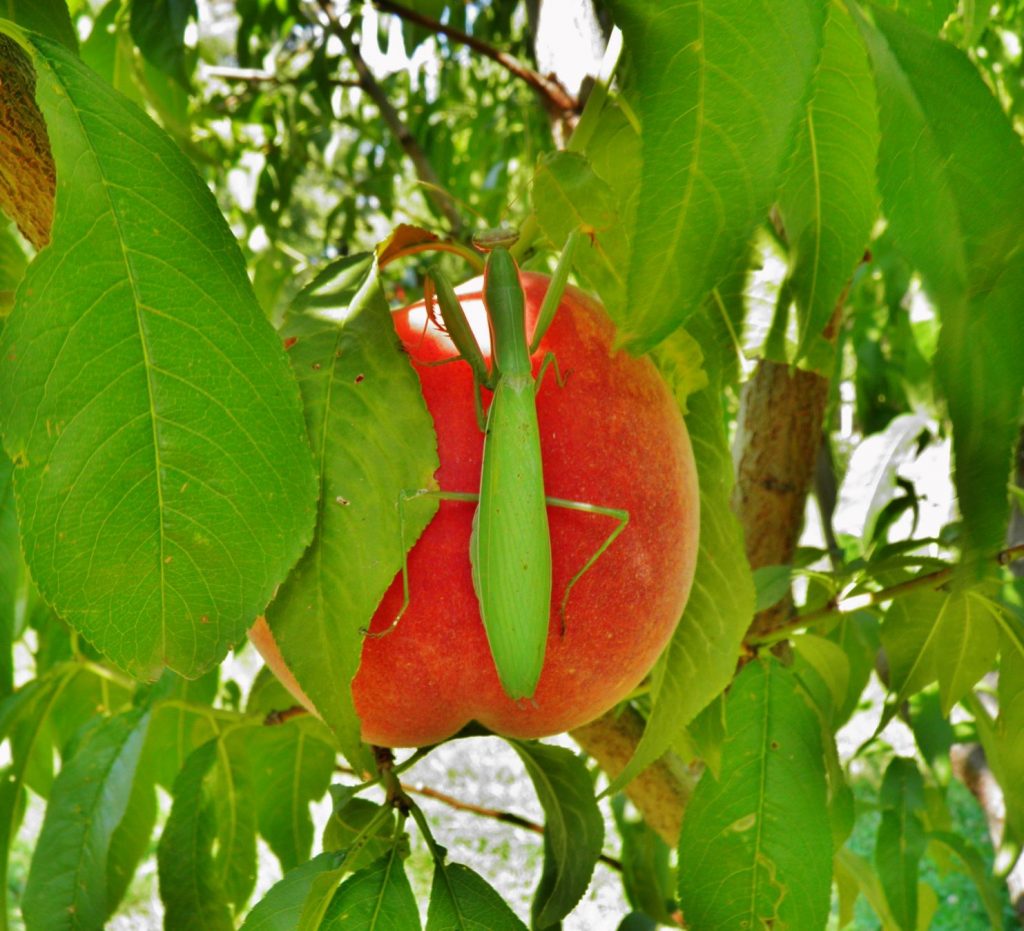
That’s what I mean, partially, by eco-organic; the other thing is relying on natural enemies such as birds and bats, insect predators and parasites, and soil microbes, to do your biological control. And to minimize or stop using even certified-organic pest control materials, like Spinosad [Entrust], or like copper, for diseases. Relying on natural nutrient cycling and on natural biological control was moving into eco-organic or ecologically-oriented organic farming.
And then veganic farming is embracing all of the eco-organic approach while also trying to figure out how to utilize an entirely plant-based fertility system. That has been our challenge.
Can you give an overview of where and what types of crops you’ve farmed?
I did conventional organic farming on a relatively large-scale on 100 acres in New Jersey and on 2,000 acres in Colorado, an organic farm with a 5,000-member CSA [community-supported agriculture]. I also did natural farming, or eco-organic farming in Georgia and Montana on my own farm. Finally, I moved into veganic farming on my Montana farm and in California, with my non-veganic orchardist husband.
And then here, in eastern Oregon, I am growing veganic vegetables, tree fruit, small fruit, nuts, dry beans, and working on grains, corn specifically. I’m now growing more of my diet here, but trying to be commercial with the orchard, as well as selling vegetables on a much smaller scale than I’ve ever done before. All of the other places I farmed were commercial farms.
Where I am now is about 211 acres, but over 100 acres of that is in a wildlife sanctuary. We have a mile of river coming out of the Wallowa Mountains, and a lovely hillside with nesting sage grouse, and deer and coyote, and elk and mountain lions and bear! It’s a nice area where they are safe and where there is no hunting and no cattle grazing. We have 70 acres that was in pasture, and we’ve taken over about 20 acres of that in our orchards and vegetable, grains and beans production.
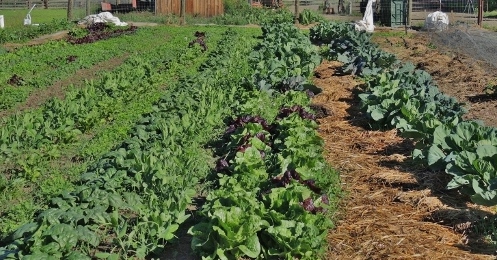
Then here’s the other challenge for me. It’s strange, the way the world has brought new lessons to me. All of the acreage had been leased by one of the biggest ranchers in the valley, who is third generation and his son fourth generation, with his kids fifth generation. They were leasing the 70 acres of the irrigated land and growing hay for cattle production. Of course, we didn’t want to do any of that but we needed to: number one, manage it and keep weeds down, and number two, bring in some income until we got the orchard up and running.
So we leased 50 of those 70 acres and we required that the rancher grow his hay organically. They hadn’t used any herbicides, but they had used conventional fertilizers. So they didn’t do that, and the first year there was a lot of complaining. We had to figure out how they could graze the cows here in the winter for five weeks, and feed the hay that they had pulled off, right there, and of course that meant I had to have cows. Not only all around me on the properties, but actually on my property. As a vegan, you can certainly understand wanting to give up on the whole project and just move to a nice little five-acre place where we wouldn’t have as much influence on having wildlife sanctuary but, by golly, we wouldn’t have to have cows.
The strange thing that occurred is that I have become good friends — good friends — with the ranchers. And they have started thinking about organic production, and the liberal neighbors in our valley are writing me letters and giving me calls thanking me for changing this rancher, who, for the first year in the seven years that he’s been growing GMO corn down the valley, has rotated his crops and not put corn in the same place. Everyone assumes that somehow it is the conversations that we have (that are mostly bantering and teasing) that have changed him. The second year of the hay crop, their yields were higher, and they started thinking that this organic stuff is might work, though yields are still lower. But it is a process of communicating regularly and negotiating.
So, as I work really hard to figure out veganic farming, down the creek where we’re leasing the land we are making a tiny stab in changing the conventional over to organic. So it kind of gets back to your first question. Going from conventional, to conventional organic, to eco-organic, to veganic — apparently I don’t get to just stop and do only ecological animal-free farming now; the universe is still sending me these other challenges.
The lovely thing is that, unlike the way I was in my twenties where I was quite strident about what was right and what was wrong and managed to not have as civil a dialogue, now I can. The rancher teases me about my skinny-ass, pathetic vegan corn, and I tease him about his GMO, poison, urea-green corn, and we can have our viewpoints and still like each other. Isn’t that amazing?
What has been your main challenge as a veganic farmer?
Definitely what I would call nitrogen fertility. I guess I’m going to say soil fertility in general. And that’s been the only challenge. Really the rest of it is what I was already doing: trying to diminish killing anything on the farm, including insects and pathogens. So the only challenge has been soil fertility, and more particularly, nitrogen fertility.
Have you been successful in overcoming these challenges, or is it still a work in progress?
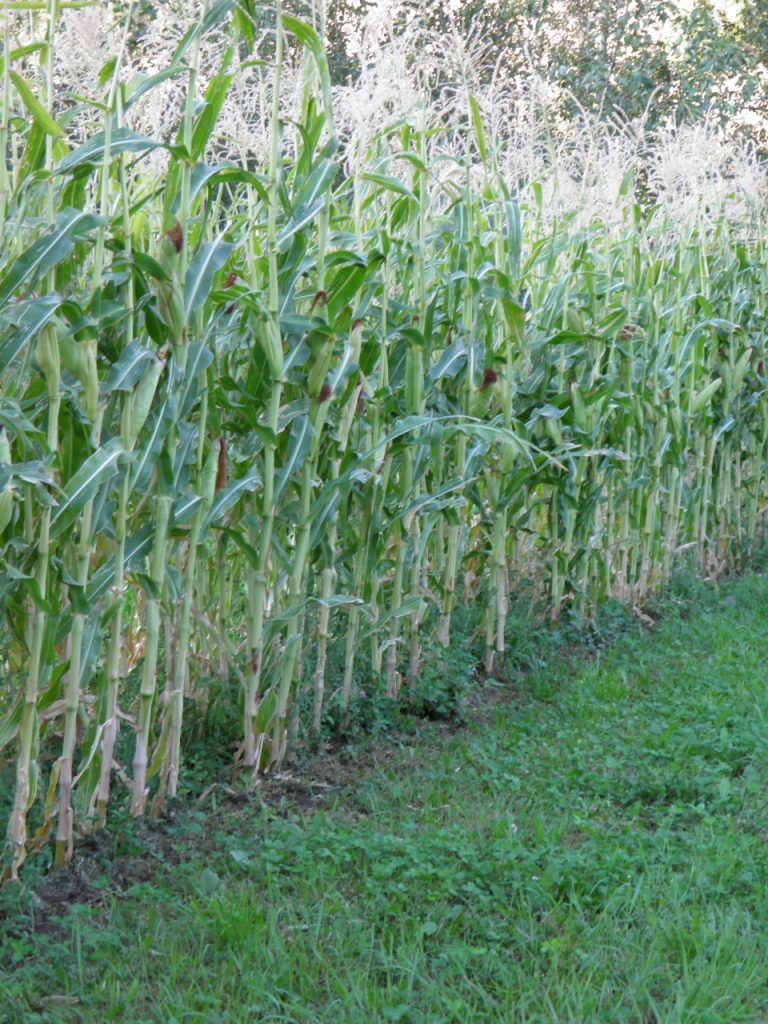
Yes, but I think it’s also a work in progress and may always be. Now that I am almost 62, I think, “Surely I should know more” but I hope I live long enough to figure it out even more. However, I do want to say that our yields and quality on this new farm after five years were mostly excellent. We had a challenge with the peaches the first year, they were not enjoying the low-nitrogen system, but they were great the second year and are beautiful this year. And the grains and beans; the beans were a light yield the first year, but certainly doable, and the corn was pathetic. My rancher neighbor was right. But this year, the bean crop was excellent and the corn was gorgeous, and of course when I dragged my rancher neighbor out to see it, he told me that he and his son had snuck up here this spring and fertilized it with some real fertilizer. It was a joke of course! I’m just giving you my teasing relationship with this guy. He had to admit that the corn looked so good that the only way it could happen is that (he teased me) he’d put conventional fertilizer down.
Why are you trying to move away from nitrogen-based and towards carbon fertility?
Conventional soil fertility knowledge is to do soil tests, to think about the crop that you’re growing, and to say, “that crop requires this much of the big three: nitrogen, phosphorus and potassium. In an organic system, usually nitrogen and phosphorus are the limiting nutrients. The question was always, how much of that do you need to add to be sufficient? That’s one way of looking at managing soil fertility. Another way of looking at it is, if we build the soil organic matter system with a carbon-based fertility regime or system, that the soil will release the nutrients as they’re needed through the microbial soil food web. The plant residues we add decompose into soil nutrients and also more slowly into soil organic matter which forms the backbone of the soil fertility system. Over time, the soil microbes break down soil organic matter and plant nutrients are released. So plant nutrients are released both through the residue that we add regularly throughout the year and through the soil’s “bank account” of soil organic matter we are building with our “carbon-farming”. We are finding that this soil organic matter system gives us most or all the fertility that we need.
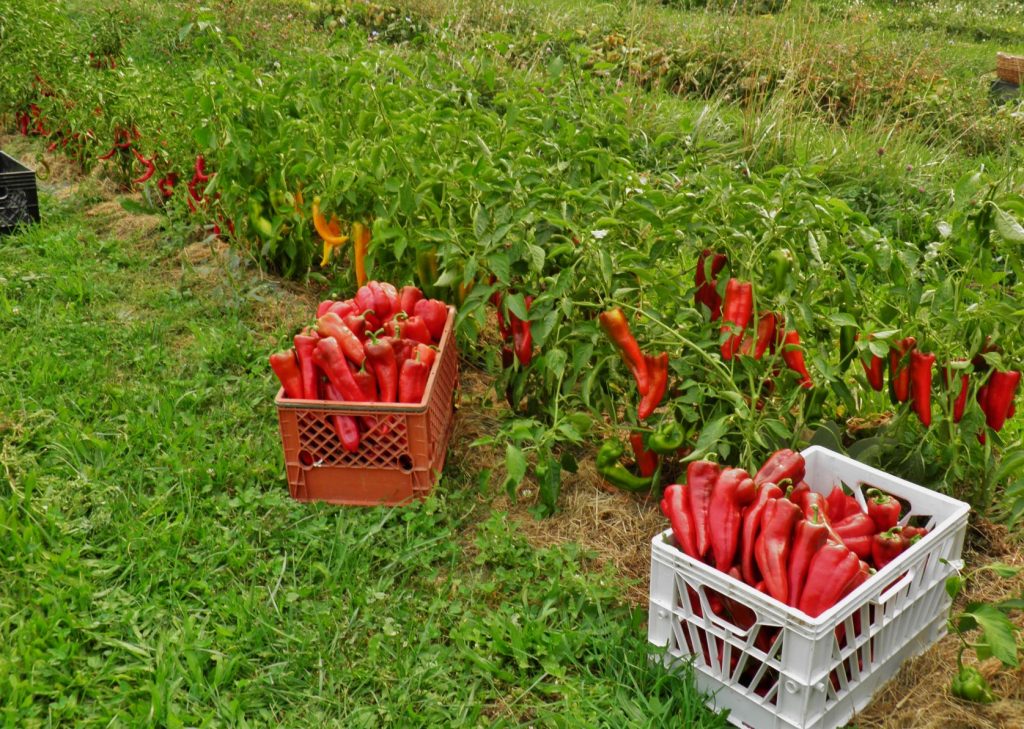
And of course, we talk about that in organic, but most of us use manures and conventional organic certainly uses a lot of side-dressing of fish meal and feather meal and high-nitrogen materials for fertility. So what we’ve been trying to figure out is how to manage a living mulch system to as closely as possible mimic a natural system. The key is maintaining an undisturbed growing root in the soil year-round. We have undisturbed legumes, grasses, and weeds between our crop rows, and we mow them periodically so they go back to the soil in the same way that prairie grasses will decompose and go back to the soil, maintaining fertility in the prairie. The same system works in the orchard, as in a forest: the way leaves go back to the soil.
What we’re doing now in the orchard is mowing the living mulch row middles, blowing that mowed mulch into the rows, and doing that repeatedly. We are also trying to balance that soil nutrient cycling, the soil organic matter system, with creating habitat right next to the crop for beneficial insects like soil-dwelling spiders and carabid beetles, and creating pollen and nectar sources right next to the crop for predators like assassin bugs and ladybugs, and parasites such as parasitic wasps and parasitic flies.
In other words, we want to have the nutrient cycle thing going on, but we also want to have undisturbed, unmowed habitat for all of the beneficial insects we depend upon. It sounds simple; it’s been a challenge to figure out but I think we’re getting it, although this will surprise you — my husband and I argued about when to mow and when not to mow, and how much habitat to leave.
The other thing that we added to this was actually Carl’s idea, my non-vegan change-the-world partner. He purchased haying equipment and we cobbled stuff together so that on one part of the farm, we hay the grass-clover-weed pasture mixture that was here, and then we haul it in a trailer to where we’re setting up our vegetable and grain and bean beds. We just put it down. So instead of feeding hay to animals and then getting the manure from the animals to put on the fields, we just leave out the animal step altogether. We take the hay and just put it on the field — and we have been getting really good results with that.
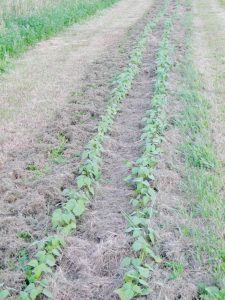
We also set up a 5-year experiment in 2016 to compare the two: mowed living mulch alone compared to mowed living mulch plus added hay mulch. So we’ve got a replicated experiment and we planted it to dry beans and two vegetable crops, red cabbage and sweet red peppers. The results of this five year experiment has taught me a lot about how to manage living mulches and hay mulch for best nutrient cycling and crop yields. It has given me ideas about how, and under what conditions, we can get away with just growing our own fertilizer right in the field, or growing it at least on our farm and bringing it from one field to another.
Why isn’t veganic farming more widespread in the United States and why are those who are at the forefront of the ecological farming movement not adopting veganic methods?
First, I am afraid that veganic farming may not have enough serious and successful larger veganic farms to be the models for others. Second, I think that the agro-ecological people very much believe that animals and animal manure make sense for maintaining soil fertility. There is a strong and growing movement towards integrating animals into “regenerative agriculture”. Regenerative agriculture and the “Real Organic” movement are challenging conventional Organic now. Here in eastern Oregon, we have not even made it to the conventional Organic stage. Ecological and veganic/stock-free farming is not even a thought. It’s not like San Francisco or Portland; there were two vegans here in this valley and one of them is eating a little bit of meat now. People don’t think that way. They think being vegan is cute, or if I’m strident, they think it’s threatening. But it’s just not in people’s thoughts. Rural America is not a place where there are many vegans. It is another part of that “rural-urban divide”.
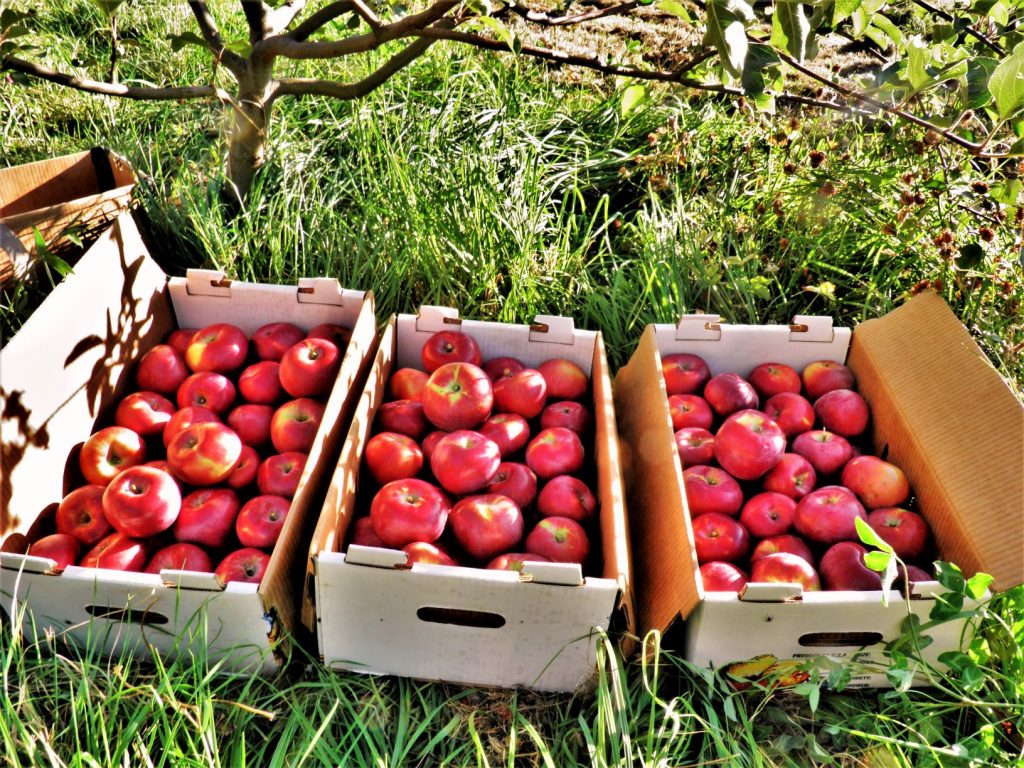
You and Carl are considered experts in agroecology or ecological farming and Woodleaf Farm has received some awards. But you don’t normally bring attention to the fact that you’re a veganic farmer. Do you think that the farming community and the environmental movement are not ready to hear that? If so, what would it take for them to be more receptive to the idea of veganics?
I have thought about this question a lot the past few years. Though I am very sorry to disappoint vegans who would like me to use the word veganic more, I realize that I have the greatest impact doing what I do well: maintaining a middle ground from which I can communicate with everyone, even with people who very much disagree with me. What I do best is being BOTH a scientist and a farmer and being BOTH a good organic and a good veganic farmer. I farm without animals or animal products and I eat a plant-based diet, but I am not a purist vegan. I eat eggs when I have dinner with vegetarians and I dearly loved my late husband who was not vegan, but who ate mostly vegan because he loved me (and I’m a better cook than he was). The two of us together changed the world more than I ever have myself. Our work showed me that my ability to stay open and “unlabeled” while gracefully and kindly combining opposites gives me power. Describing my work as “ecological farming” gives me access to more people while veganic farming seems to limit my audience.
And here is my favorite example: an old friend who is an organic crop consultant for several large organic farms and a small farmer in California has just told me he now agrees that grazing animals have a negative impact on beneficial insect habitat. He said: “Attached is a photo that proves you were right. You told me that my hens were negatively affecting the large-sized beneficial arthropods on my farm, and I thought that you were a vegan crank and that overall the hens were beneficial by eating large pests and ignoring the small beneficials. But, the rosemary growing where I fenced out the hens is bigger, healthier, with no insect damage compared to the smaller, insect-damaged rosemary growing where then hens grazed. I still like the hens for their eggs, manure, lawn mowing, and weed, ant and slug control. But can’t justify them ecologically anymore!”. This is the kind of impact I want to have! People who once, or still, farm or think differently are not threatened so much by what I do as an “ecological farmer”. That gives them the room to come to their own change, their own way.
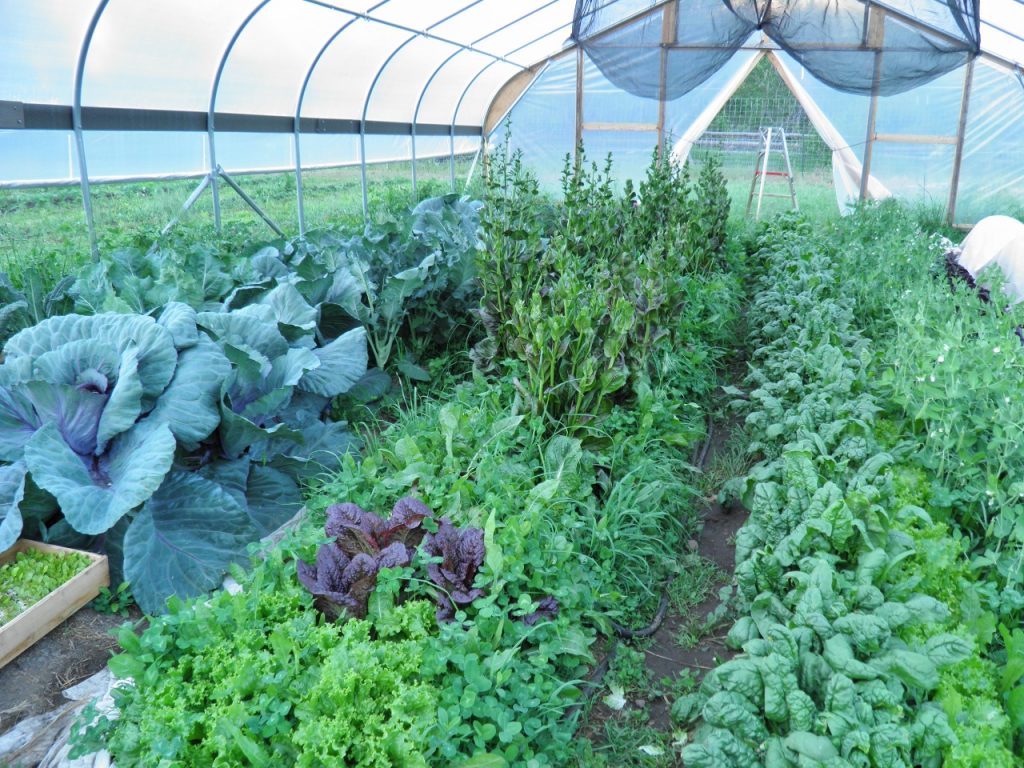
Sometimes when I’m giving presentations, I stand up and say, “We all have a context from which we come. I’m going to present all of my system and my data, and you need to know that, number one, I’ve always been a commercial farmer, and number two, I’m a vegan.” Carl used to make jokes that he didn’t know that he was farming veganically until I came, but we pretty much focused on trying to reach a broad ecological audience. We thought that, without labeling what we do, people say, “Oh, wow! You can do it with a plant-based system.”
I probably won’t get certified as a “veganic farm”. It is possible that people would ask me more about veganic if I did. When I do use the word and people don’t understand, I use George Bernard Shaw; I say, “Animals are my friends and I don’t eat my friends.” That’s almost all I have to say anymore. Otherwise I let my ecological, animal-free, plant-based farming methods and the quality of my crops speak for themselves and answer questions as people ask them.
Carl was not a vegan, but farmed without animals or animal inputs for a very long time. You have experienced some challenges by choosing to stick to this way of farming, so what was his motivation in keeping with it?
First, Carl was an orchardist, and I think that this high-carbon, low-nitrogen farming is easier in a perennial system and orchard crops. It’s much easier than with vegetables. Second, Carl was intuitive in the way he approached soil health, and he believed that manures — high-nitrogen animal-based fertilizers — unbalance the nutrients of a farm system. That it’s unbalanced fertility. And he believed that there’s more pollution and there’s less of a strong microbial community built.
As I said, I don’t know if the science is entirely there, although I am beginning to find some good science to back up what he felt intuitively. My reason, obviously, for being a veganic farmer is the one I always give to people. Scientifically, I think that it is a challenge, but Carl never did and now I am becoming convinced.
People speak of the importance of soil as a carbon sink, and present grazing as key to building healthy soil, as if this were an established scientific truth. Is soil as important as they say, and do you think they’re correct in thinking that grazing is the solution?
What I am most proud of is that my minimum soil disturbance farm shows that “regenerative agriculture” does not require grazing animals to be ecologically sustainable. I have a great example of regenerative agriculture working only with plants. I do think soil is the thing that we should focus on. As I said, Carl was not a vegan but he was quite taken by the research challenge of showing that you can have high-carbon farming that doesn’t involve animals. I think that may be, in the end, our biggest impact. It is certainly my biggest impact now.
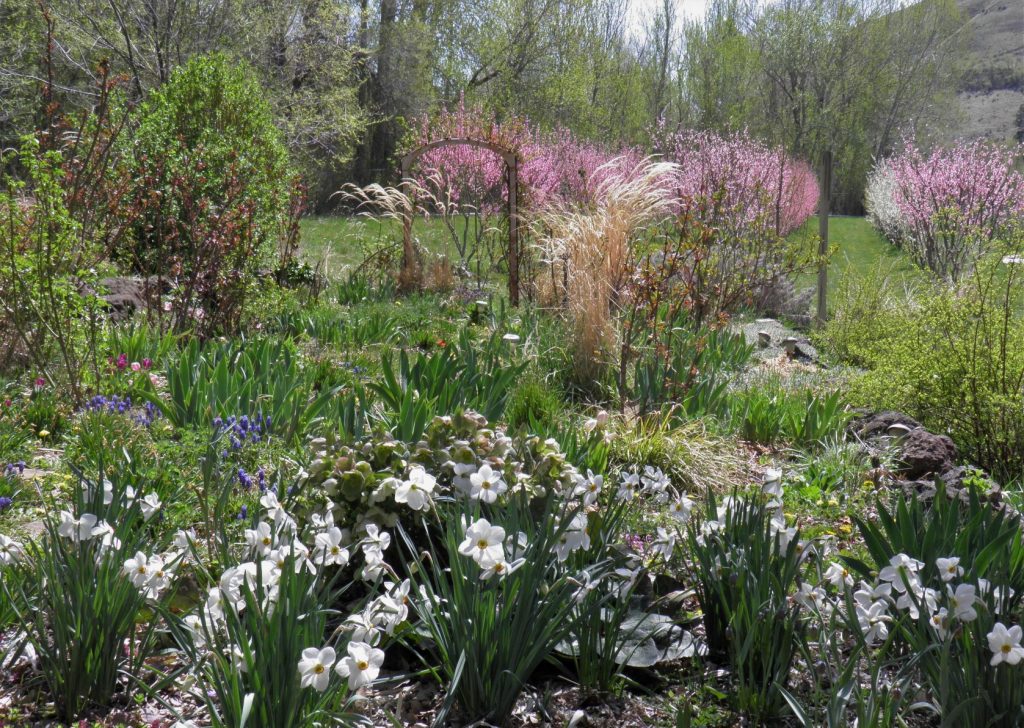
What role do you see for consumers and activists in the food movement in helping build a sustainable and compassionate food system?
The most important role! I think the consumers have far more power than anyone else in making veganic farming happen. If people start asking for veganic or stock-free produce the way they’re asking for non-GMO, the whole world will change. So I’m doing my part to say, “I know it can be done.” But far more important than showing that we can have a fertility system that is plant-based and works as well for commercial farmers, would be for consumers to ask for veganic.
It’s empowering to feel like we might be able to have an impact.
More so than anything! Look at what’s happening with GMOs and the fact that Bayer- Monsanto is now trying to figure out how to call it something besides GMO, because consumers are making an impact. Imagine if that was veganic or stock-free — wow.
Now that I am farming by myself, I don’t have the energy to farm and do research and work on veganic marketing. So I market in the way that is easiest for me. However, Woodleaf Farm is relatively close to Portland so one of our ideas had been to sell veganic fruit in Portland as part of a veganic CSA. Portland is the perfect place to do it because there is an active and organized vegan community. The next powerful step, I think, is to bring together successful veganic/stock-free farms with supportive vegan communities and create easy marketing systems (like CSAs) that take some of the marketing stress off of the farmer.
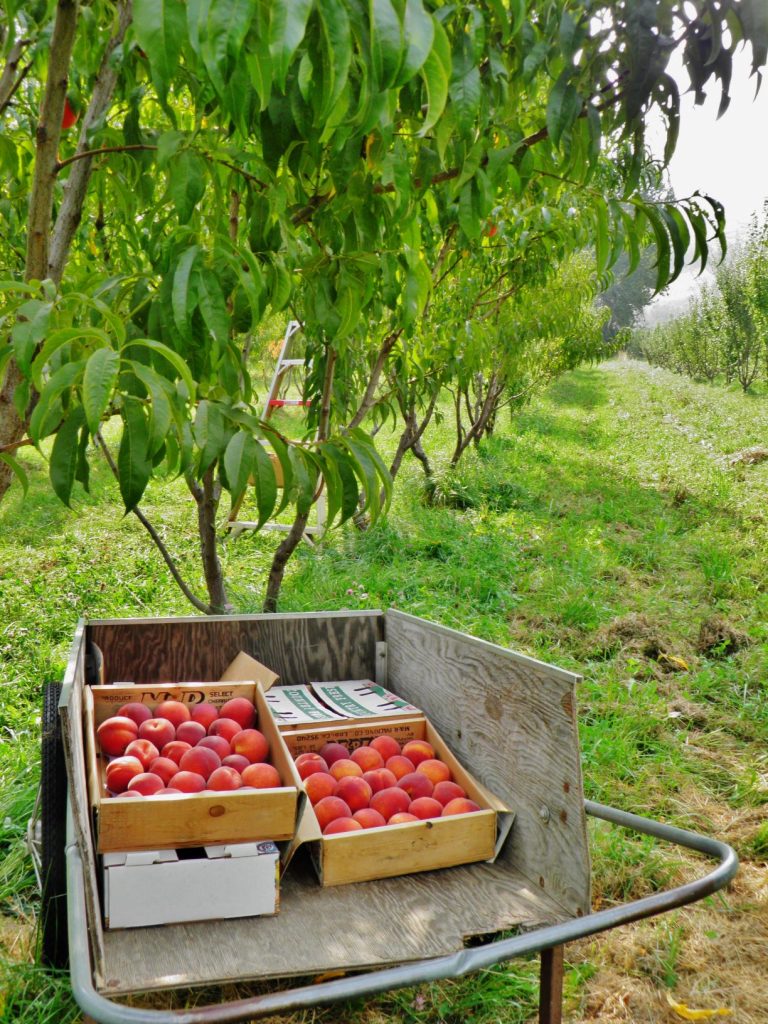
Image credits: Helen Atthowe
